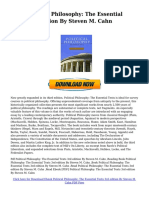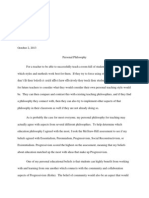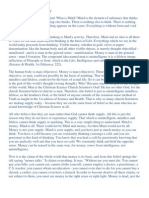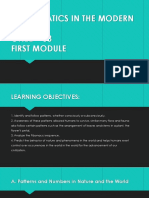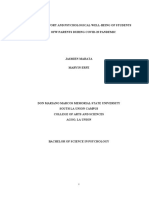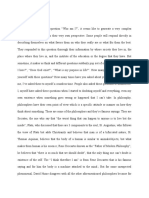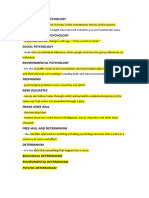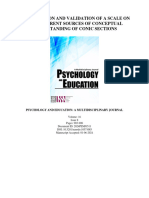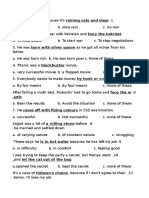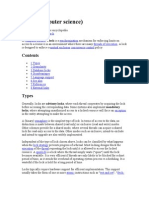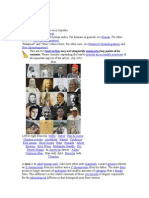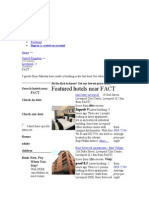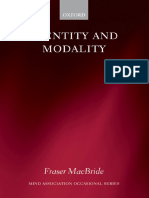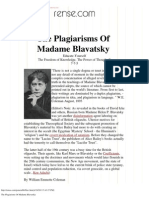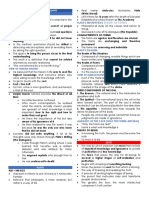Reality: Reality Is The State of Things As They
Reality: Reality Is The State of Things As They
Uploaded by
Ayaz Saa'irCopyright:
Available Formats
Reality: Reality Is The State of Things As They
Reality: Reality Is The State of Things As They
Uploaded by
Ayaz Saa'irOriginal Description:
Original Title
Copyright
Available Formats
Share this document
Did you find this document useful?
Is this content inappropriate?
Copyright:
Available Formats
Reality: Reality Is The State of Things As They
Reality: Reality Is The State of Things As They
Uploaded by
Ayaz Saa'irCopyright:
Available Formats
Reality
From Wikipedia, the free encyclopedia Jump to: navigation, search For other uses, see Reality (disambiguation). Reality is the state of things as they actually exist, rather than as they may appear or might be imagined.[1] In a wider definition, reality includes everything that is and has been, whether or not it is observable or comprehensible. A still more broad definition includes everything that has existed, exists, or will exist. Philosophers, mathematicians, and other ancient and modern thinkers, such as Aristotle, Plato, Frege, Wittgenstein, and Russell, have made a distinction between thought corresponding to reality, coherent abstractions (thoughts of things that are imaginable but not real), and that which cannot even be rationally thought. By contrast existence is often restricted solely to that which has physical existence or has a direct basis in it in the way that thoughts do in the brain. Reality is often contrasted with what is imaginary, delusional, (only) in the mind, dreams, what is false, what is fictional, or what is abstract. At the same time, what is abstract plays a role both in everyday life and in academic research. For instance, causality, virtue, life and distributive justice are abstract concepts that can be difficult to define, but they are only rarely equalled with pure delusions. Both the existence and reality of abstractions is in dispute: one extreme position regard them as mere words, another position regard them as higher truths than less abstract concepts. This disagreement is the basis of the philosophical Problem of universals. The truth refers to what is real, while falsity refers to what is not. Fictions are considered not real.
Contents
1 Related concepts o 1.1 Reality, world views, and theories of reality 2 Western philosophy o 2.1 Being o 2.2 Perception o 2.3 Abstract objects and mathematics o 2.4 Properties o 2.5 Time and space o 2.6 Possible worlds o 2.7 Theories of everything (TOE) and philosophy o 2.8 Phenomenological reality o 2.9 Skeptical hypotheses
3 Physical sciences o 3.1 Scientific realism o 3.2 Realism and locality in physics o 3.3 Role of the observer in quantum mechanics o 3.4 Multiverse o 3.5 Scientific theories of everything 4 Technology o 4.1 Virtual reality and cyberspace o 4.2 "RL" in internet culture 5 See also 6 References 7 External links
Related concepts
See Also: Truth and Fact.
Reality, world views, and theories of reality
Further information: World view A common colloquial usage would have reality mean "perceptions, beliefs, and attitudes toward reality," as in "My reality is not your reality." This is often used just as a colloquialism indicating that the parties to a conversation agree, or should agree, not to quibble over deeply different conceptions of what is real. For example, in a religious discussion between friends, one might say (attempting humor), "You might disagree, but in my reality, everyone goes to heaven." Reality can be defined in a way that links it to world views or parts of them (conceptual frameworks): Reality is the totality of all things, structures (actual and conceptual), events (past and present) and phenomena, whether observable or not. It is what a world view (whether it be based on individual or shared human experience) ultimately attempts to describe or map. Certain ideas from physics, philosophy, sociology, literary criticism, and other fields shape various theories of reality. One such belief is that there simply and literally is no reality beyond the perceptions or beliefs we each have about reality. Such attitudes are summarized in the popular statement, "Perception is reality" or "Life is how you perceive reality" or "reality is what you can get away with" (Robert Anton Wilson), and they indicate anti-realism that is, the view that there is no objective reality, whether acknowledged explicitly or not. Many of the concepts of science and philosophy are often defined culturally and socially. This idea was elaborated by Thomas Kuhn in his book The Structure of Scientific
Revolutions (1962). The Social Construction of Reality, a book about the sociology of knowledge written by Peter L. Berger and Thomas Luckmann, was published in 1966.
Western philosophy
Philosophy addresses two different aspects of the topic of reality: the nature of reality itself, and the relationship between the mind (as well as language and culture) and reality. On the one hand, ontology is the study of being, and the central topic of the field is couched, variously, in terms of being, existence, "what is", and reality. The task in ontology is to describe the most general categories of reality and how they are interrelated. If a philosopher wanted to proffer a positive definition of the concept "reality", it would be done under this heading. As explained above, some philosophers draw a distinction between reality and existence. In fact, many analytic philosophers today tend to avoid the term "real" and "reality" in discussing ontological issues. But for those who would treat "is real" the same way they treat "exists", one of the leading questions of analytic philosophy has been whether existence (or reality) is a property of objects. It has been widely held by analytic philosophers that it is not a property at all, though this view has lost some ground in recent decades. On the other hand, particularly in discussions of objectivity that have feet in both metaphysics and epistemology, philosophical discussions of "reality" often concern the ways in which reality is, or is not, in some way dependent upon (or, to use fashionable jargon, "constructed" out of) mental and cultural factors such as perceptions, beliefs, and other mental states, as well as cultural artifacts, such as religions and political movements, on up to the vague notion of a common cultural world view, or Weltanschauung. The view that there is a reality independent of any beliefs, perceptions, etc., is called realism. More specifically, philosophers are given to speaking about "realism about" this and that, such as realism about universals or realism about the external world. Generally, where one can identify any class of object, the existence or essential characteristics of which is said not to depend on perceptions, beliefs, language, or any other human artifact, one can speak of "realism about" that object. One can also speak of anti-realism about the same objects. Anti-realism is the latest in a long series of terms for views opposed to realism. Perhaps the first was idealism, so called because reality was said to be in the mind, or a product of our ideas. Berkeleyan idealism is the view, propounded by the Irish empiricist George Berkeley, that the objects of perception are actually ideas in the mind. In this view, one might be tempted to say that reality is a "mental construct"; this is not quite accurate, however, since in Berkeley's view perceptual ideas are created and coordinated by God. By the 20th century, views similar to Berkeley's were called phenomenalism. Phenomenalism differs from Berkeleyan idealism primarily in that Berkeley believed that minds, or souls, are not merely ideas nor made up of ideas, whereas varieties of phenomenalism, such as that advocated by Russell, tended to go farther to say that the mind itself is merely a
collection of perceptions, memories, etc., and that there is no mind or soul over and above such mental events. Finally, anti-realism became a fashionable term for any view which held that the existence of some object depends upon the mind or cultural artifacts. The view that the so-called external world is really merely a social, or cultural, artifact, called social constructionism, is one variety of anti-realism. Cultural relativism is the view that social issues such as morality are not absolute, but at least partially cultural artifact. A correspondence theory of knowledge about what exists claims that "true" knowledge of reality represents accurate correspondence of statements about and images of reality with the actual reality that the statements or images are attempting to represent. For example, the scientific method can verify that a statement is true based on the observable evidence that a thing exists. Many humans can point to the Rocky Mountains and say that this mountain range exists, and continues to exist even if no one is observing it or making statements about it.
Being
The nature of being is a perennial topic in metaphysics. For, instance Parmenides taught that reality was a single unchanging Being, whereas Heraclitus wrote that all things flow. The 20th century philosopher Heidegger thought previous philosophers have lost sight the question of Being (qua Being) in favour of the questions of beings (existing things), so that a return to the Parmenidean approach was needed. An ontological catalogue is an attempt to list the fundamental constituents of reality. The question of whether or not existence is a predicate has been discussed since the Early Modern period, not least in relation to the ontological argument for the existence of God. Existence, that something is, has been contrasted with essence, the question of what something is. Since existence without essence seems blank, it associated with nothingness by philosophers such as Hegel. Nihilism represents an extremely negative view of being, the absolute a positive one.
Perception
The question of direct or "nave" realism, as opposed to indirect or "representational" realism, arises in the philosophy of perception and of mind out of the debate over the nature of conscious experience;[2][3] the epistemological question of whether the world we see around us is the real world itself or merely an internal perceptual copy of that world generated by neural processes in our brain. Nave realism is known as direct realism when developed to counter indirect or representative realism, also known as epistemological dualism,[4] the philosophical position that our conscious experience is not of the real world itself but of an internal representation, a miniature virtual-reality replica of the world. Timothy Leary coined the influential term Reality Tunnel, by which he means a kind of representative realism. The theory states that, with a subconscious set of mental filters formed from their beliefs and experiences, every individual interprets the same world
differently, hence "Truth is in the eye of the beholder". His ideas influenced the work of his friend Robert Anton Wilson.
Abstract objects and mathematics
The status of abstract entities, particularly numbers, is a topic of discussion in mathematics. In the philosophy of mathematics, the best known form of realism about numbers is Platonic realism, which grants them abstract, immaterial existence. Other forms of realism identify mathematics with the concrete physical universe. Anti-realist stances include formalism and fictionalism. Some approaches are selectively realistic about some mathematical objects but not others. Finitism rejects infinite quantities. ultra-finitism accepts finite quantities up to a certain amount. Constructivism and intuitionism are realistic about objects that can be explicitly constructed, but reject the use of the principle of the excluded middle to prove existence by reductio ad absurdum. The traditional debate has focused on whether an abstract (immaterial, intelligible) realm of numbers has existed in addition to the physical (sensible, concrete) world. A recent development is the mathematical universe hypothesis, the theory that only a mathematical world exists, with the finite, physical world being an illusion within it. An extreme form of realism about mathematics is the mathematical multiverse hypothesis advanced by Max Tegmark. Tegmark's sole postulate is: All structures that exist mathematically also exist physically. That is, in the sense that "in those [worlds] complex enough to contain self-aware substructures [they] will subjectively perceive themselves as existing in a physically 'real' world".[5][6] The hypothesis suggests that worlds corresponding to different sets of initial conditions, physical constants, or altogether different equations should be considered real. The theory can be considered a form of Platonism in that it posits the existence of mathematical entities, but can also be considered a mathematical monism in that it denies that anything exists except mathematical objects.
Properties
Main article: Problem of universals The problem of universals is an ancient problem in metaphysics about whether universals exist. Universals are general or abstract qualities, characteristics, properties, kinds or relations, such as being male/female, solid/liquid/gas or a certain colour,[7] that can be predicated of individuals or particulars or that individuals or particulars can be regarded as sharing or participating in. For example, Scott, Pat, and Chris have in common the universal quality of being human or humanity.
The realist school claims that universals are real they exist and are distinct from the particulars that instantiate them. There are various forms of realism. Two major forms are Platonic realism and Aristotelian realism.[8] Platonic realism is the view that universals are real entities and they exist independent of particulars. Aristotelian realism, on the other hand, is the view that universals are real entities, but their existence is dependent on the particulars that exemplify them. Nominalism and conceptualism are the main forms of anti-realism about universals.
Time and space
Main article: Philosophy of space and time A traditional realist position in ontology is that time and space have existence apart from the human mind. Idealists deny or doubt the existence of objects independent of the mind. Some anti-realists whose ontological position is that objects outside the mind do exist, nevertheless doubt the independent existence of time and space. Kant, in the Critique of Pure Reason, described time as an a priori notion that, together with other a priori notions such as space, allows us to comprehend sense experience. Kant denies that either space or time are substance, entities in themselves, or learned by experience; he holds rather that both are elements of a systematic framework we use to structure our experience. Spatial measurements are used to quantify how far apart objects are, and temporal measurements are used to quantitatively compare the interval between (or duration of) events. Although space and time are held to be transcedentally ideal in this sense, they are also empirically real, i.e. not mere illusions. Idealist writers such as J. M. E. McTaggart in The Unreality of Time have argued that time is an illusion. As well as differing about the reality of time as a whole, metaphysical theories of time can differ in their ascriptions of reality to the past, present and future separately.
Presentism holds that the past and future are unreal, and only an ever changing present is real. The block universe theory, also known as Eternalism, holds that past, present and future are all real, but the passage of time is an illusion. It is often said to have a scientific basis in relativity. The growing block universe theory holds that past and present are real, but the future is not.
Time, and the related concepts of process and evolution are central to the system-building metaphysics of A. N. Whitehead and Charles Hartshorne.
Possible worlds
The term "possible world" goes back to Leibniz's theory of possible worlds, used to analyse necessity, possibility, and similar modal notions. Modal realism is the view, notably propounded by David Kellogg Lewis, that all possible worlds are as real as the actual world. In short: the actual world is regarded as merely one among an infinite set of logically possible worlds, some "nearer" to the actual world and some more remote. Other theorists may use the Possible World framework to express and explore problems without committing to it ontologically. Possible world theory is related to alethic logic: a proposition is necessary if it is true in all possible worlds, and possible if it is true in at least one. The many worlds interpretation of quantum mechanics is a similar idea in science.
Theories of everything (TOE) and philosophy
Main article: Theory of everything (philosophy) The philosophical implications of a physical TOE are frequently debated. For example, if philosophical physicalism is true, a physical TOE will coincide with a philosophical theory of everything. The "system building" style of metaphysics attempts to answer all the important questions in a coherent way, providing a complete picture of the world. Plato and Aristotle could be said to be early examples of comprehensive systems. In the early modern period (17th and 18th centuries), the system-building scope of philosophy is often linked to the ratioanlist method of philosophy,that is the technique of deducing the nature of the world by pure a priori reason. Examples from the early modern period include the Leibniz's Monadology, Descarte's Dualism, Spinoza's Monism. Hegel's Absolute idealism and Whitehead's Process philosophy were later systems. Other philosophers do not believe its techniques can aim so high. Some scientists think a more mathematical approach than philosophy is needed for a TOE, for instance Stephen Hawking wrote in A Brief History of Time that even if we had a TOE, it would necessarily be a set of equations. He wrote, "What is it that breathes fire into the equations and makes a universe for them to describe?".[9]
Phenomenological reality
On a much broader and more subjective level,[specify] private experiences, curiosity, inquiry, and the selectivity involved in personal interpretation of events shapes reality as seen by one and only one individual[citation needed] and hence is called phenomenological. While this form of reality might be common to others as well, it could at times also be so unique to oneself as to never be experienced or agreed upon by anyone else. Much of the kind of experience deemed spiritual occurs on this level of reality. Phenomenology is a philosophical method developed in the early years of the twentieth century by Edmund Husserl and a circle of followers at the universities of Gttingen and Munich in Germany. Subsequently, phenomenological themes were taken up by
philosophers in France, the United States, and elsewhere, often in contexts far removed from Husserl's work. The word phenomenology comes from the Greek phainmenon, meaning "that which appears", and lgos, meaning "study". In Husserl's conception, phenomenology is primarily concerned with making the structures of consciousness, and the phenomena which appear in acts of consciousness, objects of systematic reflection and analysis. Such reflection was to take place from a highly modified "first person" viewpoint, studying phenomena not as they appear to "my" consciousness, but to any consciousness whatsoever. Husserl believed that phenomenology could thus provide a firm basis for all human knowledge, including scientific knowledge, and could establish philosophy as a "rigorous science".[10] Husserl's conception of phenomenology has been criticised and developed not only by himself, but also by his student and assistant Martin Heidegger, by existentialists, such as Maurice Merleau-Ponty, Jean-Paul Sartre, and by other philosophers, such as Paul Ricoeur, Emmanuel Levinas, and Dietrich von Hildebrand.[11]
Skeptical hypotheses
Skeptical hypotheses in philosophy suggest that reality is very different from what we think it is; or at least that we cannot prove it is not. Examples include:
The "Brain in a vat" hypothesis is cast in scientific terms. It supposes that one might be a disembodied brain kept alive in a vat, and fed false sensory signals, by a mad scientist. The "Dream argument" of Descartes and Zhuangzi supposes reality to be indistinguishable from a dream. Descarte's Evil demon is a being "as clever and deceitful as he is powerful, who has directed his entire effort to misleading me." The five minute hypothesis (or omphalos hypothesis or Last Thursdayism) suggests that the world was created recently together with records and traces indicating a greater age. The Matrix hypothesis or Simulated reality hypothesis suggest that we might be inside a computer simulation or virtual reality.
Physical sciences
Scientific realism
Scientific realism is, at the most general level, the view that the world described by science (perhaps ideal science) is the real world, as it is, independent of what we might take it to be. Within philosophy of science, it is often framed as an answer to the question "how is the success of science to be explained?" The debate over what the success of science involves centers primarily on the status of entities that are not directly observable
discussed by scientific theories. Generally, those who are scientific realists state that one can make reliable claims about these entities (viz., that they have the same ontological status) as directly observable entities, as opposed to instrumentalism.
Realism and locality in physics
Realism in the sense used by physicists does not equate to realism in metaphysics.[12] The latter is the claim that the world is mind-independent: that even if the results of a measurement do not pre-exist the act of measurement, that does not require that they are the creation of the observer. Furthermore, a mind-independent property does not have to be the value of some physical variable such as position or momentum. A property can be dispositional (or potential), i.e. it can be a tendency: in the way that glass objects tend to break, or are disposed to break, even if they do not actually break. Likewise, the mindindependent properties of quantum systems could consist of a tendency to respond to particular measurements with particular values with ascertainable probability.[13] Such an ontology would be metaphysically realistic, without being realistic in the physicist's sense of "local realism" (which would require that a single value be produced with certainty). A closely related term is counterfactual definiteness (CFD), used to refer to the claim that one can meaningfully speak of the definiteness of results of measurements that have not been performed (i.e. the ability to assume the existence of objects, and properties of objects, even when they have not been measured). Local realism is a significant feature of classical mechanics, of general relativity, and of electrodynamics; but quantum mechanics has shown that quantum entanglement is possible. This was rejected by Einstein, who proposed the EPR paradox, but it was subsequently quantified by Bell's inequalities.[14] If Bell's inequalities are violated, either local realism or counterfactual definiteness must be incorrect; but some physicists dispute that experiments have demonstrated Bell's violations, on the grounds that the sub-class of inhomogeneous Bell inequalities has not been tested or due to experimental limitations in the tests. Different interpretations of quantum mechanics violate different parts of local realism and/or counterfactual definiteness.
Role of the observer in quantum mechanics
The quantum mindbody problem refers to the philosophical discussions of the mind body problem in the context of quantum mechanics. Since quantum mechanics involves quantum superpositions, which are not perceived by observers, some interpretations of quantum mechanics place conscious observers in a special position. The founders of quantum mechanics debated the role of the observer, and of them, Wolfgang Pauli and Werner Heisenberg believed that it was the observer that produced collapse. This point of view, which was never fully endorsed by Niels Bohr, was denounced as mystical and anti-scientific by Albert Einstein. Pauli accepted the term, and described quantum mechanics as lucid mysticism.[15]
Heisenberg and Bohr always described quantum mechanics in logical positivist terms. Bohr also took an active interest in the philosophical implications of quantum theories such as his complementarity, for example.[16] He believed quantum theory offers a complete description of nature, albeit one that is simply ill suited for everyday experiences which are better described by classical mechanics and probability. Bohr never specified a demarcation line above which objects cease to be quantum and become classical. He believed that it was not a question of physics, but one of philosophy. Eugene Wigner reformulated the "Schrdinger's cat" thought experiment as "Wigner's friend" and proposed that the consciousness of an observer is the demarcation line which precipitates collapse of the wave function, independent of any realist interpretation. Commonly known as "consciousness causes collapse", this interpretation of quantum mechanics states that observation by a conscious observer is what makes the wave function collapse.
Multiverse
The multiverse is the hypothetical set of multiple possible universes (including the historical universe we consistently experience) that together comprise everything that exists: the entirety of space, time, matter, and energy as well as the physical laws and constants that describe them. The term was coined in 1895 by the American philosopher and psychologist William James.[17] In the many-worlds interpretation (MWI), one of the mainstream interpretations of quantum mechanics, there are an infinite number of universes and every possible quantum outcome occurs in at least one universe. The structure of the multiverse, the nature of each universe within it and the relationship between the various constituent universes, depend on the specific multiverse hypothesis considered. Multiverses have been hypothesized in cosmology, physics, astronomy, religion, philosophy, transpersonal psychology and fiction, particularly in science fiction and fantasy. In these contexts, parallel universes are also called "alternative universes", "quantum universes", "interpenetrating dimensions", "parallel dimensions", "parallel worlds", "alternative realities", "alternative timelines", and "dimensional planes," among others.
Scientific theories of everything
A theory of everything (TOE) is a putative theory of theoretical physics that fully explains and links together all known physical phenomena, and predicts the outcome of any experiment that could be carried out in principle. The theory of everything is also called the final theory.[18] Many candidate theories of everything have been proposed by theoretical physicists during the twentieth century, but none have been confirmed experimentally. The primary problem in producing a TOE is that general relativity and quantum mechanics are hard to unify. This is one of the unsolved problems in physics. Initially, the term "theory of everything" was used with an ironic connotation to refer to various overgeneralized theories. For example, a great-grandfather of Ijon Tichy, a
character from a cycle of Stanisaw Lem's science fiction stories of the 1960s, was known to work on the "General Theory of Everything". Physicist John Ellis[19] claims to have introduced the term into the technical literature in an article in Nature in 1986.[20] Over time, the term stuck in popularizations of quantum physics to describe a theory that would unify or explain through a single model the theories of all fundamental interactions and of all particles of nature: general relativity for gravitation, and the standard model of elementary particle physics which includes quantum mechanics for electromagnetism, the two nuclear interactions, and the known elementary particles. Current candidates for a theory of everything include string theory, M theory, and loop quantum gravity.
Technology
Virtual reality and cyberspace
Virtual reality (VR) is a term that applies to computer-simulated environments that can simulate physical presence in places in the real world, as well as in imaginary worlds.
Reality-Virtuality Continuum. The Virtuality Continuum is a continuous scale ranging between the completely virtual, a Virtuality, and the completely real: Reality. The reality-virtuality continuum therefore encompasses all possible variations and compositions of real and virtual objects. It has been described as a concept in new media and computer science, but in fact it could be considered a matter of anthropology. The concept was first introduced by Paul Milgram.
[21]
The area between the two extremes, where both the real and the virtual are mixed, is the so-called Mixed reality. This in turn is said to consist of both Augmented Reality, where the virtual augments the real, and Augmented virtuality, where the real augments the virtual. Cyberspace, the world's computer systems considered as an interconnected whole, can be thought of as a virtual reality; for instance, it is portrayed as such in the cyberpunk fiction of William Gibson and others. Second life and MMORPGs such as World of Warcraft are examples of artificial environments or virtual worlds (falling some way short of full virtual reality) in cyberspace.
"RL" in internet culture
On the Internet, "real life" refers to life in the real world. It generally references life or consensus reality, in contrast to an environment seen as fiction or fantasy, such as virtual
reality, lifelike experience, dreams, novels, or movies. Online, the acronym "IRL" stands for "in real life", with the meaning "not on the Internet".[22] Sociologists engaged in the study of the Internet have determined that someday, a distinction between online and real-life worlds may seem "quaint", noting that certain types of online activity, such as sexual intrigues, have already made a full transition to complete legitimacy and "reality". [23] The abbreviation "RL" stands for "real life". For example, one can speak of "meeting in RL" someone whom one has met in a chat or on an Internet forum. It may also be used to express an inability to use the Internet for a time due to "RL problems".
See also
This section may be in need of reorganization to comply with Wikipedia's layout guidelines. Please help by editing the article to make improvements to the overall structure. (June 2013) Absolute Emanationism Nagarjuna Sunyata (philosophy) Empiricism Ontology Surrealism Alternate Existence Paranormal Vanilla Sky history Explanatory Paramnesia The Advaita model Phenomenon Truman Allegory of the False Show Principle of Cave Tulpa awakening locality Anosognosia Fiction The Usual Psychosis Authenticity Fictionalism Suspects Rashomon Roland Barthes Waking Fregoli (film) Jorge Luis Life (film) delusion Real life Borges Imagination Real world Zhuangzi Capgras Hallucination Reality in delusion Hyperreality Buddhism Charles Fort Illusion Reality shifts Consensus Immanuel (mysticism) reality Reality-based Kant Cotard delusion Language and community Counterfactual (politics) thought history Reality TV Map and Delusion Red pill territory Determinism Marshall Reification Derealization McLuhan (disambiguation Phillip K. Dick The Matrix ) Sapir-Whorf Dissociation Maya (illusion) hypothesis Dream Mental Semiotics Dreamtime representation Simulacrum Mindville (religion) Simulated Dreamworld Nihilism reality Skepticism E-prime Noumenon
Social constructionism Solipsism
References
1. Jump up ^ Compact Oxford English Dictionary of Current English, Oxford University Press, 2005. (Full entry for reality: "reality noun (pl. realities) 1 the state of things as they actually exist, as opposed to an idealistic or notional idea of them. 2 a thing that is actually experienced or seen. 3 the quality of being lifelike. 4 the state or quality of having existence or substance.") 2. Jump up ^ Lehar, Steve. (2000). The Function of Conscious Experience: An Analogical Paradigm of Perception and Behavior, Consciousness and Cognition. 3. Jump up ^ Lehar, Steve. (2000). Nave Realism in Contemporary Philosophy, The Function of Conscious Experience. 4. Jump up ^ Lehar, Steve. Representationalism 5. Jump up ^ Tegmark, Max (February 2008). "The Mathematical Universe". Foundations of Physics 38 (2): 101150. arXiv:0704.0646. Bibcode:2008FoPh...38..101T. doi:10.1007/s10701-007-9186-9. 6. Jump up ^ Tegmark (1998), p. 1. 7. Jump up ^ Loux (2001), p.4 8. Jump up ^ Price (1953), among others, sometimes uses such Latin terms 9. Jump up ^ as quoted in [Artigas, The Mind of the Universe, p.123] 10. Jump up ^ Joseph Kockelmans (2001). Edmund Husserl's phenomenology (2 ed.). Purdue University Press. pp. 311314. ISBN 1-55753050-5. 11. Jump up ^ Steven Galt Crowell (2001). Husserl, Heidegger, and the space of meaning: paths toward transcendental phenomenology. Northwestern University Press. p. 160. ISBN 0-8101-1805-X. 12. Jump up ^ Norsen, T. Against "Realism" 13. Jump up ^ Ian Thomson's dispositional quantum mechanics 14. Jump up ^ Ben Dov, Y. Local Realism and the Crucial experiment. 15. Jump up ^ Juan Miguel Marin (2009). "'Mysticism' in quantum mechanics: the forgotten controversy". European Journal of Physics 30: 807822. Bibcode:2009EJPh...30..807M. doi:10.1088/0143-0807/30/4/014. link, summarized here 16. Jump up ^ John Honner (2005). "Niels Bohr and the Mysticism of Nature". Zygon Journal of Science and Religion 173: 243253. 17. Jump up ^ James, William, The Will to Believe, 1895; and earlier in 1895, as cited in OED's new 2003 entry for "multiverse": "1895 W. JAMES in Internat. Jrnl. Ethics 6 10 Visible nature is all plasticity and indifference, a multiverse, as one might call it, and not a universe." 18. Jump up ^ Weinberg (1993)
19.
Jump up ^ Ellis, John (2002). "Physics gets physical (correspondence)". Nature 415 (6875): 957. Bibcode:2002Natur.415..957E. doi:10.1038/415957b. 20. Jump up ^ Ellis, John (1986). "The Superstring: Theory of Everything, or of Nothing?". Nature 323 (6089): 595598. Bibcode:1986Natur.323..595E. doi:10.1038/323595a0. 21. Jump up ^ Milgram, Paul; H. Takemura, A. Utsumi, F. Kishino (1994). "Augmented Reality: A class of displays on the reality-virtuality continuum" (pdf). Proceedings of Telemanipulator and Telepresence Technologies. pp. 2351 34. Retrieved 2007-03-15. 22. Jump up ^ "AcronymFinder.com search for IRL". 23. Jump up ^ Don Slater (2002). "Social Relationships and Identity On-line and Off-line". In Leah, Sonia, Lievrouw, and Livingstone. Handbook of New Media: Social Shaping and Consequences of ICTs. Sage Publications Inc. pp. 533543. ISBN 0-7619-6510-6.
External links
Find more about Reality at Wikipedia's sister projects Definitions and translations from Wiktionary Media from Commons Learning resources from Wikiversity Quotations from Wikiquote Source texts from Wikisource Textbooks from Wikibooks
C.D. Broad on Reality Stanford Encyclopedia of Philosophy on Realism Video: Carl Sagan on the 4th Dimension Explanation Video: Animated version of the above with Dr Quantum - Flatland Phenomenology Online: Materials discussing and exemplifying phenomenological research Concept and Reality, a Meditatiion Perspective The Illusion of Reality by Jim AL-Khalili The Matrix as Metaphysics by David Chalmers The Universes of Max Tegmark
[show] v t
Philosophy
[show] v t e
Metaphysics
Categories: Concepts in metaphysics Ontology Reality Reality by type
Navigation menu
Create account Log in Article Talk Read View source View history
Main page Contents Featured content Current events Random article Donate to Wikipedia
Interaction
Help About Wikipedia Community portal Recent changes Contact page
Toolbox Print/export Languages
Afrikaans Aragons Azrbaycanca () Bosanski Catal esky Dansk Deutsch Eesti Espaol Esperanto Euskara Fiji Hindi Franais Galego Hrvatski Ilokano Bahasa Indonesia slenska Italiano Kurd Latina Latvieu Lietuvi Magyar
Bahasa Melayu Nederlands Norsk bokml Norsk nynorsk Occitan Ozbekcha Piemontis Polski Portugus Romn Scots Shqip Sicilianu Simple English Slovenina Slovenina / srpski Srpskohrvatski / Suomi Svenska /tatara Trke Ting Vit Volapk Winaray Yorb
Edit links This page was last modified on 2 October 2013 at 01:49. Text is available under the Creative Commons Attribution-ShareAlike License; additional terms may apply. By using this site, you agree to the Terms of Use and Privacy Policy. Wikipedia is a registered trademark of the Wikimedia Foundation, Inc., a nonprofit organization. Privacy policy About Wikipedia Disclaimers Contact Wikipedia Developers Mobile view
You might also like
- @PDFNMD Political Philosophy The Essential Texts 3rd Edition by Steven M Cahn Ebook PDFDocument2 pages@PDFNMD Political Philosophy The Essential Texts 3rd Edition by Steven M Cahn Ebook PDFleo dwi payana0% (24)
- Great Minds of The Western Intellectual Tradition, 3rd EdDocument474 pagesGreat Minds of The Western Intellectual Tradition, 3rd Edamaan8butt100% (1)
- Personal PhilosophyDocument5 pagesPersonal Philosophyapi-242541951No ratings yet
- Analyzing Quantitative Research ProblemDocument1 pageAnalyzing Quantitative Research ProblemShannaiah Kim Bali20% (5)
- SUPPLY by Mary Baker EddyDocument3 pagesSUPPLY by Mary Baker Eddymaryalberici100% (2)
- Figure of Speech Definition, Types and ExamplesDocument3 pagesFigure of Speech Definition, Types and ExamplesmaryNo ratings yet
- Welcome To Our 1 Module For Second Semester: Chapter 1: Course Introduction Applied Social Sciences Chapter 2: CounselingDocument10 pagesWelcome To Our 1 Module For Second Semester: Chapter 1: Course Introduction Applied Social Sciences Chapter 2: CounselingHUMSS 11-BNo ratings yet
- Children and Adolescent Literature FINALS 1st SEMDocument8 pagesChildren and Adolescent Literature FINALS 1st SEMJesserick Paunel EmpelesNo ratings yet
- What Is Theme-Based Learning?Document11 pagesWhat Is Theme-Based Learning?chama100% (1)
- Inquiries, Investagation Q3 WEEK 5-WPS OfficeDocument5 pagesInquiries, Investagation Q3 WEEK 5-WPS OfficeLinel Martinez100% (1)
- Lexical Sematics Vs Phrasal SemanticsDocument1 pageLexical Sematics Vs Phrasal SemanticsSalam MohammadNo ratings yet
- Compositional SemanticsDocument12 pagesCompositional SemanticsKrystelle Joy ZipaganNo ratings yet
- Cognitivism: Cognitive Theories Paradigms and Perspectives 0 CommentsDocument6 pagesCognitivism: Cognitive Theories Paradigms and Perspectives 0 CommentsDr-Najmunnisa KhanNo ratings yet
- Active Passive VoiceDocument26 pagesActive Passive VoiceAman BeriwalNo ratings yet
- Chapter 1 Introduction - Art CriticismDocument51 pagesChapter 1 Introduction - Art CriticismRohazlina HassimNo ratings yet
- Personal Teaching PhilosophyDocument2 pagesPersonal Teaching Philosophyapi-356438163No ratings yet
- Methods of Philosophizing: Lesson TwoDocument7 pagesMethods of Philosophizing: Lesson TwoJanet PaggaoNo ratings yet
- Module 1Document44 pagesModule 1Mac John Teves PobleteNo ratings yet
- Embodied Spirit by Jose CalasanzDocument9 pagesEmbodied Spirit by Jose CalasanzJJ ArabiaNo ratings yet
- Characteristics of A Descriptive ResearchDocument2 pagesCharacteristics of A Descriptive ResearchandrewNo ratings yet
- Types of Data: NominalDocument2 pagesTypes of Data: NominalMadison HartfieldNo ratings yet
- Intellectual Disabilities ScriptDocument6 pagesIntellectual Disabilities Scriptapi-302509341No ratings yet
- Em1 Prelim ExamDocument5 pagesEm1 Prelim ExamJunalyn Bonifacio100% (1)
- Course Title: Stylistics Level: BS 7 Course Code: ELL 403 Course DescriptionDocument4 pagesCourse Title: Stylistics Level: BS 7 Course Code: ELL 403 Course Descriptionmuhammad faheemNo ratings yet
- Creative Nonfic ReviewerDocument8 pagesCreative Nonfic ReviewerDarlito AblasNo ratings yet
- WRBS11 Q3 Mod2Document69 pagesWRBS11 Q3 Mod2ADONIS ARANILLONo ratings yet
- Social Science and Philosophy M5Document10 pagesSocial Science and Philosophy M5Fobe Lpt NudaloNo ratings yet
- Chapter 5 Grammatical Categories and Word ClassesDocument34 pagesChapter 5 Grammatical Categories and Word ClassesJoyce Rodriguez100% (1)
- Gec2108 Lesson5 ActDocument4 pagesGec2108 Lesson5 Actligaya delgadoNo ratings yet
- Course Module EL. 100 Week 4Document19 pagesCourse Module EL. 100 Week 4Joevannie AceraNo ratings yet
- Parmenides Metaphysics: Parmenides' Great Contribution To Philosophy Was The Method of Reasoned Proof ForDocument2 pagesParmenides Metaphysics: Parmenides' Great Contribution To Philosophy Was The Method of Reasoned Proof ForMarissa Asim100% (1)
- Meaning and Nature of PhilosophyDocument48 pagesMeaning and Nature of PhilosophyJohn Patrick Q. BarawidNo ratings yet
- Final Annotated BibliographyDocument10 pagesFinal Annotated Bibliographyapi-301639691No ratings yet
- Social Psychology and MobilizationDocument14 pagesSocial Psychology and MobilizationRexes John Carlos AngelesNo ratings yet
- The Relationship Between Academic Intelligence and Procrastination of Grade 12 StudentsDocument8 pagesThe Relationship Between Academic Intelligence and Procrastination of Grade 12 Studentsjeliena-malazarteNo ratings yet
- Vygotsky Bruner Lesson PlanDocument4 pagesVygotsky Bruner Lesson Planapi-527515693No ratings yet
- Parental Support ThesisDocument66 pagesParental Support ThesismarkNo ratings yet
- USELFModule 3. Unfolding The Mental SelfDocument19 pagesUSELFModule 3. Unfolding The Mental SelfChocolate CheeksNo ratings yet
- Philosophical and Sociological TheoriesDocument3 pagesPhilosophical and Sociological TheoriesErielle Stephanie CollinsNo ratings yet
- Abrams Annotated BibliographyDocument6 pagesAbrams Annotated BibliographyBenjamin AbramsNo ratings yet
- Education Is Self-Learning: A Reflection On PlatoDocument5 pagesEducation Is Self-Learning: A Reflection On Platokorireed100% (1)
- Understand The SelfDocument4 pagesUnderstand The SelfJanna Marie Deocampo100% (1)
- ResearchDocument30 pagesResearchAnthonySavilloCarampatanaNo ratings yet
- Reflection 4 Educational PsychologyDocument1 pageReflection 4 Educational PsychologyZelliha BüyükNo ratings yet
- Philo Reviewer 4th QuarterDocument6 pagesPhilo Reviewer 4th QuarterCharles EspiloyNo ratings yet
- Dominant Approaches and Ideas: Structural - FunctionalismDocument22 pagesDominant Approaches and Ideas: Structural - FunctionalismShen Eugenio100% (1)
- Millenials Oral Expressionion of LoveDocument19 pagesMillenials Oral Expressionion of LovePrincess Canceran BulanNo ratings yet
- Ed201 Lesson Number 5-8Document10 pagesEd201 Lesson Number 5-8FayeNo ratings yet
- PracRes01 11 Q2 M7Document13 pagesPracRes01 11 Q2 M7Bello, Romalaine Anne C.No ratings yet
- Speak in English ZoneDocument1 pageSpeak in English ZoneKevin JeremyNo ratings yet
- Research Pre TestDocument10 pagesResearch Pre TestRazneb LeinadNo ratings yet
- Final Requirement in UTSDocument6 pagesFinal Requirement in UTSArlane AlonNo ratings yet
- Reviewer Sa Intro To Psych!!!!!!!Document4 pagesReviewer Sa Intro To Psych!!!!!!!Allysa Nicole MaglanqueNo ratings yet
- DISS Module Week 5-7Document9 pagesDISS Module Week 5-7Airene NopalNo ratings yet
- Related LiteratureDocument14 pagesRelated LiteratureChryzaPaguiriganNo ratings yet
- Senior High School: It Poorly Structured or Too Long and DetailedDocument5 pagesSenior High School: It Poorly Structured or Too Long and DetailedDuaneNo ratings yet
- FINAL PAPER - The Impact of HyFlex Modality On The Communication and Social Skills Among Humanities and Social Sciences StudentsDocument101 pagesFINAL PAPER - The Impact of HyFlex Modality On The Communication and Social Skills Among Humanities and Social Sciences Studentssherryroseandes100% (1)
- Guide To Write A Literature MapDocument2 pagesGuide To Write A Literature MapPsych05No ratings yet
- Genre Subgenre: Categories of LiteratureDocument15 pagesGenre Subgenre: Categories of LiteraturezernovojNo ratings yet
- Construction and Validation of A Scale On The Different Sources of Conceptual Understanding of Conic SectionsDocument7 pagesConstruction and Validation of A Scale On The Different Sources of Conceptual Understanding of Conic SectionsPsychology and Education: A Multidisciplinary JournalNo ratings yet
- Constructivist Learning Theory (Ness)Document4 pagesConstructivist Learning Theory (Ness)Yam YamNo ratings yet
- The Importance of Developing Reading for Improved Writing Skills in the Literature on Adult Student's LearningFrom EverandThe Importance of Developing Reading for Improved Writing Skills in the Literature on Adult Student's LearningNo ratings yet
- History of Philosophy: Philosophy for Beginners - Introduction & Basics of PhilosophyFrom EverandHistory of Philosophy: Philosophy for Beginners - Introduction & Basics of PhilosophyNo ratings yet
- First Year Main2Document49 pagesFirst Year Main2Ayaz Saa'irNo ratings yet
- First Year Main2Document49 pagesFirst Year Main2Ayaz Saa'irNo ratings yet
- The M Usic .: StoneDocument9 pagesThe M Usic .: StoneAyaz Saa'irNo ratings yet
- Oedipus SettingDocument4 pagesOedipus SettingAyaz Saa'irNo ratings yet
- Navigation Search Element 79 (Anthology) Gold (Color) Gold (Disambiguation)Document45 pagesNavigation Search Element 79 (Anthology) Gold (Color) Gold (Disambiguation)Ayaz Saa'irNo ratings yet
- Lock (Computer Science) : Locks, Where Attempting Unauthorized Access To A Locked Resource Will Force AnDocument9 pagesLock (Computer Science) : Locks, Where Attempting Unauthorized Access To A Locked Resource Will Force AnAyaz Saa'irNo ratings yet
- Social ClassDocument20 pagesSocial ClassAyaz Saa'irNo ratings yet
- Doubt: From Wikipedia, The Free Encyclopedia Jump To:, This Article Is About The Mental State. For Other Uses, SeeDocument10 pagesDoubt: From Wikipedia, The Free Encyclopedia Jump To:, This Article Is About The Mental State. For Other Uses, SeeAyaz Saa'irNo ratings yet
- May Not Adequately Key Points of Its Contents. Please Consider Expanding The Lead ToDocument15 pagesMay Not Adequately Key Points of Its Contents. Please Consider Expanding The Lead ToAyaz Saa'irNo ratings yet
- Glass: From Wikipedia, The Free Encyclopedia Jump To:, This Article Is About The Material. For Other Uses, SeeDocument27 pagesGlass: From Wikipedia, The Free Encyclopedia Jump To:, This Article Is About The Material. For Other Uses, SeeAyaz Saa'irNo ratings yet
- Aleph & Tav Amightywind RUACH Ha KODESHDocument6 pagesAleph & Tav Amightywind RUACH Ha KODESHAyaz Saa'irNo ratings yet
- Religion: Navigation Search Religion (Disambiguation) Religious Institute Religious (Catholicism)Document45 pagesReligion: Navigation Search Religion (Disambiguation) Religious Institute Religious (Catholicism)Ayaz Saa'irNo ratings yet
- BobyDocument1 pageBobyAyaz Saa'irNo ratings yet
- Featured Hotels Near FACT: PKR Viewed Hotels BookingsDocument5 pagesFeatured Hotels Near FACT: PKR Viewed Hotels BookingsAyaz Saa'irNo ratings yet
- Peace: Quality StandardsDocument20 pagesPeace: Quality StandardsAyaz Saa'irNo ratings yet
- Conflict: Navigation SearchDocument4 pagesConflict: Navigation SearchAyaz Saa'irNo ratings yet
- CH 4 Daily Essential Dua A4Document6 pagesCH 4 Daily Essential Dua A4amjadmmaniyarNo ratings yet
- History of Islamic Philosophy - SampleDocument124 pagesHistory of Islamic Philosophy - SampleAnonymous o3QDRuLop100% (2)
- Modern Philosophy: o o o o o o o oDocument6 pagesModern Philosophy: o o o o o o o orizabesmonteNo ratings yet
- Plotinus and Spinoza Re Evaluating The PDocument16 pagesPlotinus and Spinoza Re Evaluating The PBruno BeribaNo ratings yet
- Empire. New Haven: Book ReviewDocument2 pagesEmpire. New Haven: Book ReviewOuarour AimaneNo ratings yet
- (Unacademy AIMT - 5) New Styles of Reasoning in Contemporary Philosophy and ScienceDocument12 pages(Unacademy AIMT - 5) New Styles of Reasoning in Contemporary Philosophy and ScienceJannu AkashNo ratings yet
- Apophatic Theology As Antidote To NihilismDocument49 pagesApophatic Theology As Antidote To NihilismAnonymous WpMUZCb935No ratings yet
- Aristotle Hylemorphism and Concepts of Potency and Actuality When Explaining Mind and The Human SoulDocument35 pagesAristotle Hylemorphism and Concepts of Potency and Actuality When Explaining Mind and The Human Soul廖承钰No ratings yet
- BRM 2022 (Critical Rationalism)Document36 pagesBRM 2022 (Critical Rationalism)ngo ngoc haNo ratings yet
- Exstasis of The ArchonsDocument7 pagesExstasis of The ArchonsJustice DubhghaillNo ratings yet
- MacBride - Identity and Modality - Oxford University Press, USA. 0199285748Document279 pagesMacBride - Identity and Modality - Oxford University Press, USA. 0199285748Esteban Combatt100% (2)
- The Categories and The Status of The PHDocument16 pagesThe Categories and The Status of The PHAllen AndersonNo ratings yet
- Kant's Analytic, Cambridge 1966, Pp. 71-99: Jonathan BennettDocument15 pagesKant's Analytic, Cambridge 1966, Pp. 71-99: Jonathan BennettMarko MarkicNo ratings yet
- TMA#02Document3 pagesTMA#02Niroshan ManoharanNo ratings yet
- Causation by David HumeDocument30 pagesCausation by David HumeMihai Zadnipru100% (1)
- Knowing and Teaching The Truth: The Pastor'S Commitment To Truth in The Postmodern LandscapeDocument11 pagesKnowing and Teaching The Truth: The Pastor'S Commitment To Truth in The Postmodern LandscapeericslauNo ratings yet
- Initial Titles NotesDocument3 pagesInitial Titles NotessamNo ratings yet
- XXXXXXXXXX 4444444Document7 pagesXXXXXXXXXX 4444444kiszkaNo ratings yet
- Crowley and The OnaDocument8 pagesCrowley and The OnaAtazothnashaas100% (1)
- 'A Glossary of Thelema' CoverDocument7 pages'A Glossary of Thelema' CoverBrian Adam Newman (Frater Pyramidatus)No ratings yet
- Greek Philosophy 3: The Milesian School - Thales, Anaximander & AnaximenesDocument1 pageGreek Philosophy 3: The Milesian School - Thales, Anaximander & Anaximenesanon_599450986No ratings yet
- The Plagiarisms of Madame BlavatskyDocument13 pagesThe Plagiarisms of Madame BlavatskyWilhelm Richard Wagner50% (2)
- PutnamDocument25 pagesPutnamBruno de OliveiraNo ratings yet
- Neo PlatonismDocument18 pagesNeo Platonismphilgrace puabenNo ratings yet
- Perspective of Philosophy Socrates: Socratic/Dialectic Method Plato'S Metaphysics (Theory of Forms)Document5 pagesPerspective of Philosophy Socrates: Socratic/Dialectic Method Plato'S Metaphysics (Theory of Forms)Alexándra NicoleNo ratings yet
- 4648 11414 1 SM PDFDocument15 pages4648 11414 1 SM PDFSnapy klp gading 2 KGD2No ratings yet
- Do-Aa Komail of Imam Ali Bin Abi Talib (A.S.)Document25 pagesDo-Aa Komail of Imam Ali Bin Abi Talib (A.S.)mtajarNo ratings yet
